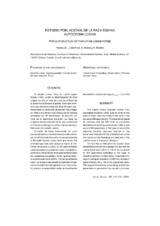Estudio poblacional de la raza equina autóctona Losina
Population study of the native Losine horse
Autor
Martínez, J.
Valera Córdoba, M.
Molina Alcalá, Antonio
Rodero Franganillo, Antonio
Editor
Universidad de Córdoba, Servicio de PublicacionesFecha
2000Materia
Número efectivoConservación
Consanguinidad
Caballo Losino
METS:
Mostrar el registro METSPREMIS:
Mostrar el registro PREMISMetadatos
Mostrar el registro completo del ítemResumen
The Losine horse, Spanish Losine Pony according to Masón (1969), gets its name for the point of origin, the Losa Valley in the north of the province of Burgos (Spain). This breed maintained its numbers until the 50s when its population declined until reaching a critical point 1986 of only around 180 specimens, in that year, in view of the alarming situation, recovery program for the breed was initiated with the establishment of the first centre for the Breeding and selection of the Losine horse in Pancorbo (Burgos). The fact that so little time has passed since establishing this centre, explains the fact that the Losine horse has a 20.31 p.100 of its population of 154 specimens belonging to the base or founding animals. Further more, it has high average of pedigree founders (16.80) that represent approximately 65 p.100 of the population base. The sequential entrance of founding animal from generation to generation has caused a low ave rage of inbreeding in the Losine horse population ( Fmedia = 1.8 p.100). El caballo Losino, Pony sp. Losino según Masón (1969), recibe su denominación del área original de cría, el Valle de Losa, en el Norte de la provincia de Burgos (España). Esta raza mantuvo sus efectivos hasta los años 50 pero posteriormente su población descendió hasta llegar en 1986 a los límites más críticos de su historia (alrededor de 180 ejemplares). En ese año, en vista de la alarmante situación, se inició un proyecto de recuperación de la raza, creándose en Pancorbo (Burgos) el primer Centro de Cría y Selección del caballo Losino. El hecho de haber transcurrido tan poco espacio de tiempo desde el momento de comenzar, en el Centro de Pancorbo, la recuperación de la Raza del Caballo Losino hace que de los 154 animales que han sido censados hasta el momento del estudio, un 20,31 p.100 sean animales pertenecientes a la población base o fundadora. Así mismo, observamos el elevado número medio de fundadores por pedigrí (16,80) que representa aproximadamente el 65 p.100 de la población base. La entrada secuencial de animales fundadores en cada intervalo generacional, ha motivado que la consanguinidad media de la población de caballos Losinos sea baja ( Fmedia = 1,8 p.100)

